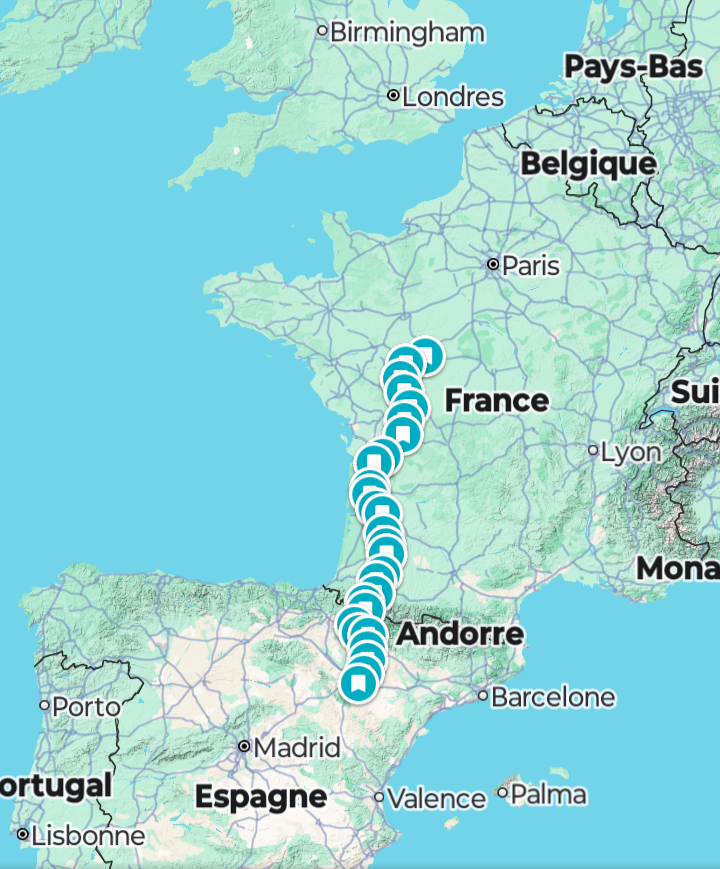

Pilgrimage Overview
A pilgrim needs a destination. Without a destination, a traveler is a vagabond. Retracing the journey of a spiritual hero has long been the pathway of a pilgrim. The journey of a pilgrim is a pilgrimage.
The European Cultural Center of Saint Martin manages an extensive network of pilgrim routes through 12 countries. Pilgrimages to his tomb in Tours began immediately after his death in 397 for devotees to pay homage to this humble and virtuous soldier-turned-pilgrim-turned-hermit-turned-monk-turned-bishop. Many of the pathways in the modern network were walked by Martin himself during the chaotic times of the withering Roman Empire, an epoch of uncertainty, miscommunication, unstable governments, mass migration caused by climate change and war.
Collectively, the Saint Martin of Tours pilgrimage network are united as the Via Sancti Martini and link many European towns which were part of the life of Saint Martin, as well as those with a significant architectural heritage of relevance to his veneration: thousands of monuments are dedicated to him, including fourteen cathedrals! These sites also have an intangible heritage that is still alive in the form of legends, traditions and folklore. This large set of routes, covering more than 5,000 km (= 3,000 mi) across and around Europe bears the general name of Via Sancti Martini. It promotes the collaboration between all the countries that the paths cross. The international efforts are united by the inexorable virtues of Saint Martin’s faith – equality, justice, charity, tolerance, and humility.
Council of Europe values
The Saint Martin Route represents the value of sharing, symbolised by the Saint’s charitable act in Amiens when he cut his cloak in half to share with a poor man who was dying of cold in the heart of winter. Behind this simple concept lies the intention to bring people together, beyond divisions of all kinds, in a single approach: sharing resources, knowledge and values. Indeed, sharing becomes a moral necessity to preserve humanity in the face of the challenge posed by globalisation, demographic expansion and ecosystem damage.
While all the routes are captivating, the pilgrimage proposed here is a cultural and historical journey by foot to explore the path that St Martin undertook in the 4th century between Zaragoza, Spain (Saragosse in French) and Tours, France.

Pilgrims will gather in Zaragoza, Spain on 7 July 2026 and walk north for 40 days on rural roads and footpaths to arrive at the tomb of St Martin in the Basilica Saint Martin in Tours, France on 15 August 2026.
How does this Pilgrimage Work?
A pilgrimage is a personal journey, but not entirely private. A small group of young – twentysomething – pilgrims will meet at a specified location in Zaragoza the afternoon before the walking adventure begins. Pilgrims will carry their personal necessities in small backpacks. A recommended packing list is available. A Smartphone with European charger, a change of clothes, toiletries, sheet/light sleeping bag, sleeping pad, ‘evening shoes’ – keep it simple – backpacks with a capacity of 25 – 35 liters are sufficient, with a target weight of 12 – 18 pounds. There is an embedded lesson of considering wants versus needs.
Routinely, each morning, pilgrims will be given a point on two GPS systems – Maps.me and Google Maps – with the instruction to arrive at that point at 5 o’clock. The location will be on average 25 km (=15 mi) distant, which is to say about 5 hours of walking distributed over 9 or 10 hours. Typically, the day’s destination will be a small village; occasionally a monastery. The GPS systems will identify pathway options. At the beginning of the journey, pilgrims will be instructed on using the GPS systems until they are comfortable walking on their own. In this way, pilgrims are free to pursue their own interests – one like to swim, so finds a route along a stream; another loves art, so finds a path that includes village churches, packed with original paintings, frescoes, statues, etc. – or chases down architecture, nature, Roman ruins, Neolithic monuments, ice cream shops… where desires compel them. Arrive at the point at 5 o’clock.
The pilgrimage coordinator will arrive at the destination in advance to arrange a place to sleep indoors with necessary amenities. Most commonly, pilgrims will make their nests scattered around a community center with a restroom, maybe a shower, other times, a sports club, maybe a school, a library, or a folk museum, or divided among the local residents… whatever a small village has to offer. It’s rare to know exactly in the morning where we might sleep at night. There’s always something. Trust, faith, confidence, no worries. Enjoy the walk, embrace the uncertainty.
Dinner and breakfast will be communal, prepared in whatever kitchen facility is available. Lunch is typically picnics of leftovers or otherwise found along individual journeys. Expenses for the meals will be shared among the pilgrims with the coordinator preparing the healthy, tasty, satiating repasts that everyone can enjoy. Groceries will periodically be distributed among the backpacks. In the past, daily budgets of $5 – $10 have been sufficient, but the world is a bit unpredictable these days, so maybe leaning on the high side is prudent. Every pilgrim is expected to contribute a fair share.
Language skills – Castilian, Catalan, and French – are beneficial, but not prerequisites. Electronic translators obviously help and the learning curve is, anyway, steep.
Pilgrims will bond fraternally, but have individual experiences. Teamwork. No pilgrim will be left behind.
Who is Saint Martin of Tours?
Saint Martin is a universal hero. The world needs heroes – true heroes who were real live people, struggling with the hardships of life, and whose lives can be seen as relevant examples of how we can each live good lives. He was the first person to be named a Christian saint who was not martyred. In other words, his life of extraordinary virtue was noted by others as being so exemplary that it should never be forgotten. It was the virtues developed since childhood, recognized during his military service, continuing after his conversion to Christianity, seen as his times as pilgrim and hermit, driving him to establish the first monastery – and then the second – in Europe, that turned the heads of the nobility, the clergy, the scholars and merchants, but most importantly, of the rural inhabitants who made up the bulk of the world in which he lived. Seventeen hundred years after his death and elevation to sainthood, his acts of compassion and sense of tolerance, equality and justice for all are held in esteem. The two monasteries are on the itinerary of this pilgrimage.
It is from the texts of Sulpicius Severus, contemporary biographer of Saint Martin, as well as those of other historians, such as Gregory of Tours, that details of his life are known. A great traveler throughout his life, this European before his time was born in 316 in Pannonia, present-day Hungary, to pagan parents. Raised in Pavia, Italy, where his father was a soldier, he was enlisted in the Roman army at fifteen. In 337, while garrisoned at Amiens, France, he shared half of his cloak to give to a poor man dying of cold. He then had the revelation of the faith and converted to Christianity. In 356 he left the army at Worms, Germany.
He then placed himself in the service of Saint Hilaire, bishop of Poitiers, in France, who trained him. Having made a great pilgrimage to find his parents in Pannonia, he converted his mother. After a stay in Milan, Italy, he took refuge on the island of Gallinaria, on the Ligurian coast. Then he returned to France to rejoin Saint Hilaire. Installed as a hermit near Poitiers, he founded the Ligugé abbey, the first monastery in the West. Abducted by the citizens of Tours, who made him their bishop on July 4, 371, he created the monastery of Marmoutier, near Tours, and founded the first rural churches in Gaul, while traveling across part of Europe (Germany, Luxembourg, Switzerland , Spain…). Saint Martin died on November 8, 397 in Candes, and was buried on November 11 in Tours. His memory has been recorded throughout Europe for seventeen centuries.
The historical figure of Saint Martin of Tours is difficult to see behind a considerable mass of texts accumulated over the centuries. The historical Martin left no writings; it is therefore through the filter of Sulpicius Severus that we can glimpse it. Notwithstanding, many churches founded by Saint Martin are still in use in the region around Tours. There are around 5,000 churches and chapels under his patronage in France alone. Martin is the most common surname in France today, and one of the most common first names. There are more than 300 towns in France named for him. His influence has never ceased. In the Orthodox church he is venerated as Saint Martin the Merciful.
References
YouTube documentaries
